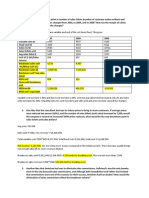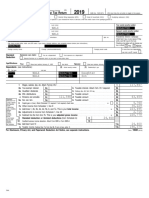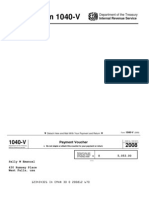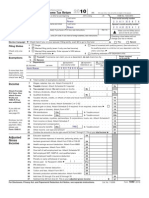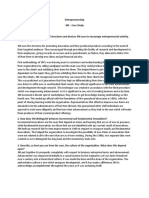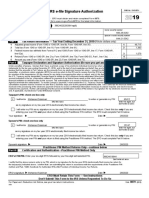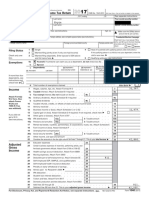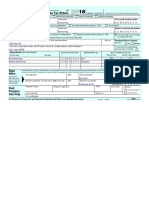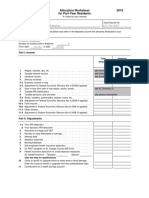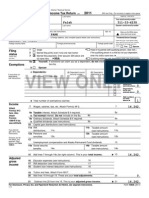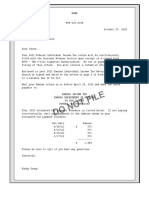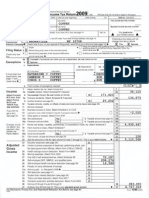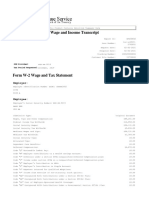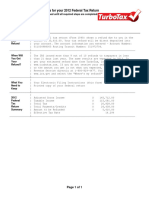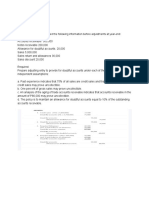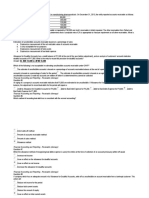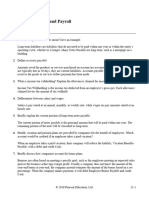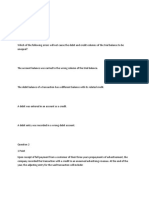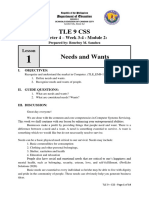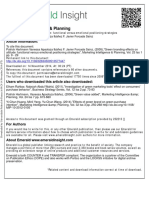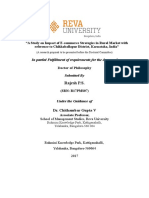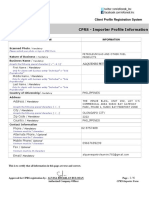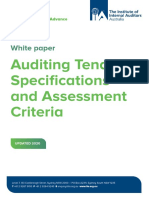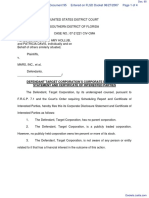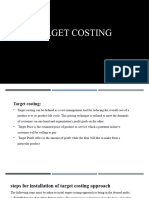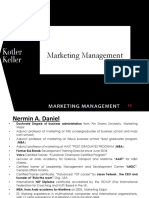ProblemC ch05
ProblemC ch05
Uploaded by
Adan FakihCopyright:
Available Formats
ProblemC ch05
ProblemC ch05
Uploaded by
Adan FakihOriginal Description:
Original Title
Copyright
Available Formats
Share this document
Did you find this document useful?
Is this content inappropriate?
Copyright:
Available Formats
ProblemC ch05
ProblemC ch05
Uploaded by
Adan FakihCopyright:
Available Formats
Chapter 05 - Receivables and Sales
PROBLEMS: SET C Calculate the amount of revenue to recognize (LO5-1) P5-1C Assume the following scenarios. Scenario 1. During 2015, Makers Consulting provides services of $100,000. The company receives an initial payment of $75,000 with the balance to be received the following year. Scenario 2. People-R-Us typically charges $75 for a one-year subscription. On January 1, 2015, Georgette, age 72, purchases a one-year subscription to the magazine and receives a 20% senior citizen discount. Scenario 3. During 2015, Waste Control provides services on account for $15,000. The customer pays for those services in 2016. Scenario 4. During 2015, Tasty Foods sells grocery items to one of its customers for $125,000 on account. Cash collections on those sales are $80,000 in 2015 and $30,000 in 2016. The remaining $15,000 is written off as uncollectible in 2016. Required: For each scenario, calculate the amount of revenue to be recognized in 2015. Record transactions related to credit sales and contra revenues (LO5-1, 5-2) P5-2C Recovery Experts (RE) specializes in data recovery from crashed hard drives. The price charged varies based on the extent of damage and the amount of data being recovered. RE offers a 10% discount to students and faculty at educational institutions. Consider the following transactions during the month of June. June 10 Lukes hard drive crashes and he sends it to RE. June 12 After initial evaluation, RE e-mails Luke to let him know that full data recovery will cost $1,600. June 13 Luke informs RE that he would like them to recover the data and that he is a student at USC, qualifying him for a 10% educational discount and reducing the cost by $160 (= $1,600 x 10%). June 16 RE performs the work and claims to be successful in recovering all data. RE asks Luke to pay within 30 days of todays date, offering a 5% discount for payment within 10 days. June 19 When Luke receives the hard drive, he notices that RE did not successfully recover all data. Approximately 25% of the data has not been recovered and he informs RE. June 20 RE reduces the amount Luke owes by 25%. June 30 Luke pays the amount owed. Required: 1. Record the necessary transactions(s) for Recovery Experts on each date. 2. Calculate net revenues. 3. Show how net revenues would be presented in the income statement. 4. Calculate net revenues if Luke had paid his bill on June 25.
Financial Accounting, 3e 2014
The McGraw-Hill Companies, Inc.,
Chapter 05 - Receivables and Sales
Record transactions related to accounts receivable (LO5-3, 5-5)
P5-3C The following events occur for Wortham Landscape Design during 2015 and 2016, its first two years of operations. February 2, 2015 July 23, 2015 December 31, 2015 April 12, 2016 June 28, 2016 Provide services to customers on account for $26,000. Receive $20,000 from customers on account. Estimate that 10% of uncollected accounts will not be received. Provide services to customers on account for $40,000. Receive $5,000 from customers for services provided in 2015.
September 13, 2016 Write off the remaining amounts owed from services provided in 2015. October 5, 2016 December 31, 2016 Receive $35,000 from customers for services provided in 2016. Estimate that 10% of uncollected accounts will not be received.
Required: 1. Record transactions for each date. 2. Post transactions to the following accounts: Cash, Accounts Receivable, and Allowance for Uncollectible Accounts. 3. Calculate the net realizable value of accounts receivable at the end of 2015 and 2016. Record transactions related to uncollectible accounts (LO5-4, 5-5) P5-4C Gable Incorporated provides legal services. During 2015, the company provides services of $500,000 on account. Of this amount, $70,000 remains uncollected at the end of the year. An aging schedule as of December 31, 2015, is provided below. Amount Receivable $40,000 15,000 9,000 6,000 $70,000 Estimated Percent Uncollectible 5% 10% 20% 40%
Age Group Not yet due 030 days past due 3160 days past due More than 60 days past due Total
Required: 1. Calculate the allowance for uncollectible accounts. 2. Record the December 31, 2015, adjustment, assuming the balance of Allowance for Uncollectible Accounts before adjustment is $500 (debit).
Financial Accounting, 3e 2014
The McGraw-Hill Companies, Inc.,
Chapter 05 - Receivables and Sales
3. On April 3, 2016, a customers account balance of $600 is written off as uncollectible. Record the write-off. 4. On July 17, 2016, the customer, whose account was written off in Requirement 3, unexpectedly pays $200 of the amount but does not expect to pay any additional amounts. Record the cash collection. Compare the direct write-off method to the allowance method (LO5-3, 5-6) P5-5C Power Corporation engages in the manufacture and sale of equipment related to alternative sources of energy. During the past year, operating revenues remained relatively flat compared to the prior year but management notices a big increase in accounts receivable. The increase in receivables is largely due to the recent economic slowdown in the commodities market. Many of the companys customers are having financial difficulty, lengthening the period of time it takes to collect on account. Below are year-end amounts. Age Group Two years ago Last year Current year Operating Revenue $2,300,000 3,100,000 3,000,000 Accounts Receivable $80,000 100,000 350,000 Average Age 13 days 11 days 27 days Accounts Written Off $10,000 15,000 0
Peter, the CEO of Power, notices that accounts written off over the past three years have been minimal and therefore suggests that no allowance for uncollectible accounts be established in the current year. Any account proving uncollectible can be charged to next years financial statements (the direct writeoff method). Required: 1. Do you agree with Peters reasoning? Explain. 2. Suppose that other companies in these industries have had similar increasing trends in accounts receivable aging. These companies also had very successful collections in the past but now estimate uncollectible accounts to be 30% because of the significant downturn in the industries. If Power uses the allowance method estimated at 30% of accounts receivable, what should be the balance of the allowance for uncollectible accounts at the end of the current year? 3. Based on your answer in Requirement 2, for what amount will total assets and expenses be misstated in the current year if Power uses the direct writeoff method? Ignore tax effects. Using estimates of uncollectible accounts to understate income (LO5-3) P5-6C Tatsuo is the CEO of Ginjo Gallery. At the end of the year, the companys accountant provides Tatsuo with the following information, before any adjusting entries. Accounts receivable Estimated percentage uncollectible Allowance for uncollectible accounts Operating income
Financial Accounting, 3e 2014
$1,000,000 5% $10,000 (credit) $240,000
The McGraw-Hill Companies, Inc.,
Chapter 05 - Receivables and Sales
Tatsuo has significant stock ownership in the company and therefore would like to keep the stock price high. Analysts on Wall Street expect the company to have operating income of $170,000. The fact that actual operating income is well-above this amount will make investors happy and help maintain a high stock price. Meeting analysts expectations will also help Tatsuo keep his job. Required: 1. Record the adjustment for uncollectible accounts using the accountants estimate of 5% of accounts receivable. 2. After the adjustment is recorded in Requirement 1, what is the revised amount of operating income? Will Ginjo Gallery still meet analysts expectations? 3. Tatsuo instructs the accountant to instead record $70,000 as bad debt expense so that operating income will exactly meet analysts expectations. By how much would total assets and operating income be misstated if the accountant records this amount? 4. Why would Wanda be motivated to manage operating income in this way? Underestimating future uncollectible accounts (LO5-3, 5-5) P5-7C By the end of its first year of operations, Gallen Corporation has credit sales of $580,000 and accounts receivable of $200,000. Given its the first year of operations, Gallens management is unsure how much allowance for uncollectible accounts it should establish. One of the companys competitors, which has been in the same industry for an extended period, estimates uncollectible accounts to be 3% of ending accounts receivable, so Gallen decides to use that same amount. However, actual write-offs in the following year were 10% of the $200,000 ( = $20,000). Gallens inexperience in the industry led to making sales to high credit risk customers. Required: 1. Record the adjustment for uncollectible accounts at the end of the first year of operations using the 3% estimate of accounts receivable. 2. By the end of the second year, Gallen has the benefit of hindsight to know that estimates of uncollectible accounts in the first year were too low. By how much did Gallen underestimate uncollectible accounts in the first year? How did this underestimation affect the reported amounts of total assets and expenses at the end of the first year? Ignore tax effects. 3. Should Gallen prepare new financial statements for the first year of operations to show the correct amount of uncollectible accounts? Explain. Record long-term notes receivable and interest revenue (LO5-8) P5-8C On June 1, 2015, Demer Consulting provides services to a customer for $150,000. To pay for the services, the customer signs a three-year, 12% note. The face amount is due at the end of the third year, while annual interest is due each June 1. Required: 1. Record the acceptance of the note on June 1, 2015. 2. Record the interest collected on June 1 for 2016 and 2017, and the adjustment for interest revenue on December 31, 2015, 2016, and 2017.
Financial Accounting, 3e 2014
The McGraw-Hill Companies, Inc.,
Chapter 05 - Receivables and Sales
3. Record the cash collection on June 1, 2018.
Financial Accounting, 3e 2014
The McGraw-Hill Companies, Inc.,
You might also like
- E0311 Hallstead JewelersDocument2 pagesE0311 Hallstead Jewelersaltemurcan kursunlu100% (1)
- Gov. Walz 2019 Federal Tax Return - RedactedDocument11 pagesGov. Walz 2019 Federal Tax Return - RedactedTim Walz for GovernorNo ratings yet
- Sally W Emanual 2008 Tax ReturnDocument5 pagesSally W Emanual 2008 Tax ReturnJackie Page100% (2)
- NATH f1040Document2 pagesNATH f1040Spencer NathNo ratings yet
- F 1040Document2 pagesF 1040Kevin RowanNo ratings yet
- Victor Benji Wemh Intuit Tax ReturnDocument41 pagesVictor Benji Wemh Intuit Tax ReturnEmo RockstarNo ratings yet
- HRBlockDocument7 pagesHRBlocksusu ultra menNo ratings yet
- Test 2 Financial Accounting PDFDocument3 pagesTest 2 Financial Accounting PDFAdrian Tajmani33% (3)
- Ass 3 - 3M Case StudyDocument2 pagesAss 3 - 3M Case StudySyed Wajih Ul Hassan GillaniNo ratings yet
- Federal 2016 :DDocument15 pagesFederal 2016 :DAnguila Angel Anguila AngelNo ratings yet
- Cicortflorina 8879Document2 pagesCicortflorina 8879Florin Cicort100% (3)
- Fernando Vazquez567935467Document21 pagesFernando Vazquez567935467Richivee100% (2)
- 2020 0605 Return MspaduaDocument1 page2020 0605 Return MspaduaEljoe VinluanNo ratings yet
- Amara Enyia's 2017 Tax ReturnDocument4 pagesAmara Enyia's 2017 Tax ReturnMark Konkol100% (1)
- 1040 ArmstrongDocument2 pages1040 Armstrongapi-458373647No ratings yet
- Jeff Bell 2012 Tax ReturnDocument71 pagesJeff Bell 2012 Tax ReturnRaylene_No ratings yet
- Taxes Amy PDFDocument7 pagesTaxes Amy PDFJsjs JsjsjjshshNo ratings yet
- Paycheck Protection Program ApplicationDocument4 pagesPaycheck Protection Program ApplicationJay Mike100% (1)
- Edgar JDocument2 pagesEdgar Japi-585014034No ratings yet
- Filing Status U.S. Individual Income Tax Return: Married Filing Jointly Qualifying Widow (Er) (QW)Document2 pagesFiling Status U.S. Individual Income Tax Return: Married Filing Jointly Qualifying Widow (Er) (QW)eddie waitesNo ratings yet
- Ivan Incisor CH 3 2014 Tax Return - For - FilingDocument6 pagesIvan Incisor CH 3 2014 Tax Return - For - FilingShakilaMissz-KyutieJenkinsNo ratings yet
- U.S. Individual Income Tax Return: Filing StatusDocument3 pagesU.S. Individual Income Tax Return: Filing StatuspyatetskyNo ratings yet
- 2013 Tax Return (Shep-Ty DBA Embrace)Document24 pages2013 Tax Return (Shep-Ty DBA Embrace)Game ChangerNo ratings yet
- Zambrano Tax-Pro & Services 2752 Eagle Canyon DR S Kissimmee, FL 34746 407-334-2907Document15 pagesZambrano Tax-Pro & Services 2752 Eagle Canyon DR S Kissimmee, FL 34746 407-334-2907Yaidhyt PradoNo ratings yet
- U.S. Individual Income Tax Return 1040A: Filing StatusDocument3 pagesU.S. Individual Income Tax Return 1040A: Filing StatusYosbanyNo ratings yet
- Marylynn Huggins - Clifden Ut State Tax Return 2013Document4 pagesMarylynn Huggins - Clifden Ut State Tax Return 2013api-2573405260% (1)
- Client Copy Return 2020 For AT PRODUCTS & SERVICES LLCDocument18 pagesClient Copy Return 2020 For AT PRODUCTS & SERVICES LLCEdwin Altamiranda100% (2)
- TaxDocument9 pagesTaxKuan ChenNo ratings yet
- 2006 Tax Return: Craig & Marilyn JamesDocument23 pages2006 Tax Return: Craig & Marilyn JamesJames4SenateNo ratings yet
- Make Necessary Changes in Only Orange Colored Fields.: Proceed To Calculation Will Be Initially "No"Document36 pagesMake Necessary Changes in Only Orange Colored Fields.: Proceed To Calculation Will Be Initially "No"xakilNo ratings yet
- Tax File 2106 Ss FileingDocument5 pagesTax File 2106 Ss FileingWALLAUERNo ratings yet
- U.S. Individual Income Tax Return: Filing StatusDocument2 pagesU.S. Individual Income Tax Return: Filing Statusjakelong82100% (1)
- MLFA Form 990 - 2016Document25 pagesMLFA Form 990 - 2016MLFANo ratings yet
- FTF1299519215531Document3 pagesFTF1299519215531Leslie Washington100% (1)
- Eric Lesser & Alison Silber - 2013 Joint Tax ReturnDocument2 pagesEric Lesser & Alison Silber - 2013 Joint Tax ReturnSteeleMassLiveNo ratings yet
- U.S. Individual Income Tax Return: Filing StatusDocument2 pagesU.S. Individual Income Tax Return: Filing Statuskenneth kittleson100% (1)
- Will Frost 2013 Tax Return - T13 - For - RecordsDocument146 pagesWill Frost 2013 Tax Return - T13 - For - RecordsjessicaNo ratings yet
- Jack & Lori Turbo Tax 2012 PDFDocument3 pagesJack & Lori Turbo Tax 2012 PDFKeith CooperNo ratings yet
- Brooklyn Museum 2019 IRS Form 990Document64 pagesBrooklyn Museum 2019 IRS Form 990Lee Rosenbaum, CultureGrrlNo ratings yet
- Perry Tax Return 2010Document38 pagesPerry Tax Return 2010Rick DunhamNo ratings yet
- Federal Electronic Filing Instructions: Tax Year 2018Document13 pagesFederal Electronic Filing Instructions: Tax Year 2018Adonis TorrefielNo ratings yet
- Rooksana Tax Return Form 2020-2021Document19 pagesRooksana Tax Return Form 2020-2021MITON CHOWDHURYNo ratings yet
- 2019 Chandler D Form 1040 Individual Tax Return - Records-ALDocument7 pages2019 Chandler D Form 1040 Individual Tax Return - Records-ALwhat is thisNo ratings yet
- 2011 Federal 1040Document2 pages2011 Federal 1040Swati SarangNo ratings yet
- Hillside Children's Center, New York 2014 IRS ReportDocument76 pagesHillside Children's Center, New York 2014 IRS ReportBeverly TranNo ratings yet
- Young Acc 137 Kongai, Tsate 1040Document26 pagesYoung Acc 137 Kongai, Tsate 1040Kathy YoungNo ratings yet
- SC Tax ReturnDocument12 pagesSC Tax ReturnCeleste KatzNo ratings yet
- File by Mail Instructions For Your 2009 Federal Tax ReturnDocument11 pagesFile by Mail Instructions For Your 2009 Federal Tax ReturnjakeNo ratings yet
- U.S. Individual Income Tax Return: See Separate InstructionsDocument4 pagesU.S. Individual Income Tax Return: See Separate InstructionsNewsTeam20100% (1)
- FTF1301242185129Document3 pagesFTF1301242185129Donna SchatzNo ratings yet
- Request For Taxpayer Identification Number and CertificationDocument4 pagesRequest For Taxpayer Identification Number and CertificationMichael RamirezNo ratings yet
- Aaron Berg w2Document2 pagesAaron Berg w2kevin kuhnNo ratings yet
- 2022 8879 (Brashier Misty) 2Document12 pages2022 8879 (Brashier Misty) 2Astrid ReiNo ratings yet
- Monica L Lindo Tax FormDocument2 pagesMonica L Lindo Tax Formapi-299234513No ratings yet
- TurboTax Print Preview 02-14-2013T20.10.08.460Document13 pagesTurboTax Print Preview 02-14-2013T20.10.08.460glenncannon1973No ratings yet
- ValixDocument12 pagesValixJESTONI RAMOSNo ratings yet
- AICPA Released Questions FAR 2015 DifficultDocument33 pagesAICPA Released Questions FAR 2015 DifficultAZNGUY100% (2)
- RecDocument5 pagesRecPrankyJellyNo ratings yet
- ch11 SolutionsDocument36 pagesch11 Solutionsaboodyuae2000No ratings yet
- Accounting - Exam - Day 1Document40 pagesAccounting - Exam - Day 1Fat AjummaNo ratings yet
- 110 WarmupDay1Document25 pages110 WarmupDay1shiieeNo ratings yet
- Acctg11e SM CH11Document52 pagesAcctg11e SM CH11titirNo ratings yet
- Togo FrenchDocument48 pagesTogo FrenchGlobal Tech SolutionNo ratings yet
- Indian Balence of PaymentDocument11 pagesIndian Balence of PaymentSubhankar AdhikaryNo ratings yet
- Tle-9 Css q4 w3-4 m2 Lds Needs-And-wants RTPDocument14 pagesTle-9 Css q4 w3-4 m2 Lds Needs-And-wants RTPilza6studyqNo ratings yet
- Cfas ReviewerDocument12 pagesCfas ReviewerRafael Capunpon VallejosNo ratings yet
- Gordon Pollack 2018Document30 pagesGordon Pollack 2018Mahesh PatilNo ratings yet
- Accounting Cycle: Exercise 6.1Document11 pagesAccounting Cycle: Exercise 6.1Joanna GarciaNo ratings yet
- Project Impact of Job Satisfaction On Employee PerformanceDocument34 pagesProject Impact of Job Satisfaction On Employee PerformanceRidz ZNo ratings yet
- Press Note 2 of FDI 2012Document2 pagesPress Note 2 of FDI 2012balaji84_caNo ratings yet
- ETL vs. ELT: Frictionless Data Integration - DiyottaDocument3 pagesETL vs. ELT: Frictionless Data Integration - DiyottaDiyottaNo ratings yet
- 4.technical AnalysisDocument49 pages4.technical AnalysisBoolean SinghNo ratings yet
- Fastcat Phase 1 Team Trim The Fat Internal Alignment Towson UniversityDocument16 pagesFastcat Phase 1 Team Trim The Fat Internal Alignment Towson UniversityShiela Mae Dagcuta CandaNo ratings yet
- Ethnomethodology For Service Design Experiments: Involving Students in Knowledge CreationDocument14 pagesEthnomethodology For Service Design Experiments: Involving Students in Knowledge CreationMarshall Sitten100% (1)
- 5D2 Adv ICo Sales Restrictions 2022 OPDocument8 pages5D2 Adv ICo Sales Restrictions 2022 OPsaravananNo ratings yet
- Marketing Intelligence & Planning: Article InformationDocument25 pagesMarketing Intelligence & Planning: Article InformationAli AhadzadehNo ratings yet
- Research Proposal For Pre Registaration Colloquim REVA UNIVERSITYDocument12 pagesResearch Proposal For Pre Registaration Colloquim REVA UNIVERSITYপ্ৰকাশ বড়াNo ratings yet
- Exporting Fresh Fruit and Vegetables To ChinaDocument38 pagesExporting Fresh Fruit and Vegetables To Chinacherrbulls100% (1)
- Tax Law AnswersDocument63 pagesTax Law AnswersMiamor NatividadNo ratings yet
- CPRS - Importer Profile Information: Client Profile Registration SystemDocument7 pagesCPRS - Importer Profile Information: Client Profile Registration SystemYssa LabahataaNo ratings yet
- Auditing Tender Specifications-White PaperDocument6 pagesAuditing Tender Specifications-White PaperTendai ChirambaNo ratings yet
- Company Profile: Eman Construction CoDocument61 pagesCompany Profile: Eman Construction CoGulzar YaseenNo ratings yet
- Blaszkowski Et Al v. Mars Inc. Et Al - Document No. 95Document4 pagesBlaszkowski Et Al v. Mars Inc. Et Al - Document No. 95Justia.comNo ratings yet
- JanjerikoalcordoponterasDocument4 pagesJanjerikoalcordoponterasGigi GiftyNo ratings yet
- BAKERY OfficeDocument33 pagesBAKERY OfficeJemal50% (2)
- Reliance Life Insurance - WikipediaDocument8 pagesReliance Life Insurance - Wikipediaarjun chaturvediNo ratings yet
- Target CostingDocument9 pagesTarget Costingtharani1771_32442248No ratings yet
- Cost Accounting Method of Costing PDFDocument2 pagesCost Accounting Method of Costing PDFvikas saini100% (1)
- 60932Document5 pages60932stevan janampa acuache0% (1)
- Marketing Management Ch. 1& 2 AAST 2022Document203 pagesMarketing Management Ch. 1& 2 AAST 2022Ahmed Fawzy0% (1)
